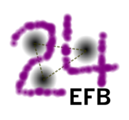The Glasgow Nuclear Physics research group has maintained a long interest in few-body physics, studying two- and three-body nucleon-nucleon interactions using real and virtual photons at the Mainz 1.6 MeV Microtron (A1, A2 collaborations) and at the Jefferson Laboratory 12 GeV accelerator (CLAS collaboration). Initial work at Mainz looked at the role of neutron-proton correlations in a range...
Preliminary results from a Jefferson Lab (JLab) experiment on electron deep inelastic scattering (DIS) from the 3H and 3He mirror nuclei will be presented. The experiment (MARATHON, “MeAsurement of the F2n/ F2p, d/u RAtios and A=3 EMC Effect in Deep Inelastic Electron Scattering Off the Tritium and Helium MirrOr Nuclei”) took data for 70 days in the period January-April 2018 in the Hall A...
Deuteron spin structure program is aimed on extraction of two and three nucleon forces information, including their spin dependent parts, from dp elastic and dp breakup processes investigated at intermediate energies. The dp elastic data were obtained at Internal Target Station of Nuclotron (JINR) in the energy range of 400-1800 MeV using polarized deuteron beam. Angular dependencies of the...
In recent times, it has become clear that inclusive Deep Inelastic Scattering does not allow to fully understand few fundamental issues about the nuclear partonic structure, such as the origin of the EMC effect. These difficulties can be overcome considering a new generation of experiments at high energy and high luminosity [1] involving exclusive scattering processes. Among them, deeply...

